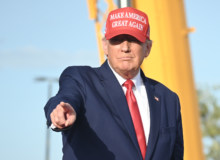Joe Biden and his foreign policy team are looking to push the U.S. back into the JCPOA Iran nuclear deal.. Leading the talks for the United States is the pro-Hamas, pro-Iran, anti-Us, anti-Israel Robert Malley/ Many, especially on the left, support reentering the ideal, not realizing that the JCPOA allows Iran to build nuclear weapons in the near future, which will place the United States, the Sunni Gulf States, and Israel in grave danger. talks to reenter the JCPOA
The liberal media won’t tell you, but Trump’s withdrawal from the deal brought peace. Without the withdrawal, there would never have been the Abraham Accords. Behind the scenes, the Arab counties working with Israel were the Sunni-led states such as the UAE, Bahrain, Sudan (and the Saudis). They were working with Israel (quietly) because they believed that Shia Iran was an existential threat. By pulling out of the Iran nuke deal (the JCPOA) and pressuring Iran with increased sanctions, Trump proved to the Sunni countries who see Iran as an existential threat that, unlike Obama, he had their backs against Iran.
The JCPOA was a capitulation to Iranian demands. Beyond that, parts of the JCPOA that Obama and Kerry bragged about the most were lies. The MSM covered up the lies back then and is still not exposing the truth about the deal. I would suspect that the President, also known as lyin Joe Biden, will join Barack Obama and John Kerry to cover up the truth.
Below are some of the most troubling lies Obama and Kerry told America about their capitulation deal with Iran:
- The JCPOA allows Iran to go nuclear between 2025 and 2030. We were told that the agreement’s goal is to ensure that Iran will be prevented from building nuclear weapons for the deal’s life. According to an op-ed written by John Kerry and Ernest Moniz published in 2015, the deal’s life is “forever.’ That was a lie. Some of the provisions expire after year 10 (2025), and the rest expire after year 15 (2030).
- lThe JCPOA gives Iran the capacity to enrich for bombs but NOT for power plants. The deal says that Iran can enrich fuel for peaceful purposes. Under the agreement, Iran is allowed to keep 5,060 centrifuges. Per the former deputy director of the CIA, Mike Morell, is enough enrichment to produce bombs but not enough for a power program.
- Iran never reported to the IAEA Their nuclear History: Iran had been non-compliant with its obligation to reveal its nuclear history. Per the JCPOA, the rogue nation was supposed to disclose its pre-deal nuclear program. This was a condition for implementing the agreement. Historical knowledge is necessary so the IAEA will know how, when, and where to inspect Iran’s program in the future. When it came time to “fess up,” Iran told the IAEA that it never had a nuclear program. The IAEA reported what it was told instead of pushing back against a blatant lie. This is another example of a breach of the accord that was published as compliance. In other words, the entire agreement was based on a lie and should never have been implemented.
Using information secretly gathered by a Mossad operation in Iran and verified by the United States in April 2018, Israeli Prime Minister Binyamin Netanyahu exposed a significant lie in the information the Iranians supplied to the IAEA in its 2015 report. The documents proved that Iran not only had a nuclear weapons program (called Amad,) but after it was supposedly canceled in 2013, the work continued. Eventually, the IAEA visited one of the sites Netanyahu identified and found traces of Uranium.
- There are no anytime anywhere inspections: Because of a secret side deal revealed by the Associated Press long before the deal was agreed to, Iran gets to self-inspect the Parchin military base with no IAEA inspectors present (more on that below). The agreement specifically “requests the Director-General of the IAEA to undertake the necessary verification and monitoring of Iran’s nuclear-related commitments for the full duration of those commitments under the JCPOA.” But after the deal was made, the Iranian authorities claimed military sites were off-limits to the IAEA. Sadly, the IAEA and countries that stayed in the agreement refuse to push the point because they don’t want Iran to seem non-compliant.
One of the problems with this refusal involves “Section T” of the deal. In Aug. 2017, the IAEA’s announced that it has been unable to verify a vital part of the JCPOA, “Section T.” That part of the deal outlines “Activities which could contribute to the design and development of a nuclear explosive device.” That inability doesn’t mean Iran violated “Section T.” It means is your guess is as good as mine because nobody knows — but the deal says the IAEA is supposed to inspect.
- Ben Rhodes admitted there were falsehoods. New York Times Magazine piece Ben Rhodes explained how he led the administration’s efforts to misrepresent the truth in order “to sell” the JCPOA to the press.
- The JCPOA lifted the ban on the Iranian ballistic missile program. Before the deal U.N. Security Council Resolution (UNSC) 1929, the council used mandatory language about ballistic missiles. It said, “It decides that Iran shall not undertake any activity related to ballistic missiles capable of delivering nuclear weapons.” The P5+1 resolution passed by the UNSC changes the language. On page 119 of the UNSC-approved JCPOA deal, the language changed from Iran “shall not” carry out ballistic missile work but merely asks them not to carry out ballistic missile development. To quote, “Iran is called upon not to undertake such activity.” Some reports say that John Kerry begged Iran not to talk about the changes.
- The deal allows Iran to go nuclear after ten years. Do you remember when John Kerry insisted the Iran nuclear deal was a “forever deal?” That was a lie. Some of the provisions expire after year 10, and the rest of them after year 15. Based on the agreement, by the end of year 15, Iran could have a nuclear infrastructure that could produce the significant quantities of weapon grade needed to create a few nuclear weapons within months, precisely what they are doing now. Iran knows it is dealing with a weak President.
- The promised sanction “snap-backs” don’t really exist. President Obama gave Europe, China, and Russia a written promise that the U.S. will guarantee their companies who make deals with Iran would not have to stop working with Iran should sanction need to be re-imposed should Iran get caught violating the P5+1 agreement.
- The deal gives Tehran the leverage to blackmail the West since the Iranians can threaten (and have threatened) to walk away from the JCPOA with a 35-day notice. Under Paragraph 36, Iran can claim that any country agreeing to the JCPOA is “not meeting its commitments” under the agreement. That triggers a 35-day set of meetings. Once that clock runs, Iran can claim the issue “has not been resolved to [its] satisfaction” and that it “deems” that the issue “constitutes significant non-performance.” Iran can then “cease performing its commitments under this JCPOA in whole or in part.”
- Iran gets to “self-inspect” at the Parchin military site. Before the agreement, the IAEA sought access to Parchin, which has long been suspected of being where Iran was developing its detonation systems for nuclear weapons. Iran even admitted using Parchin to test exploding bridge wires used as nuclear detonators, but they claimed the test explosions were not for weapons development.
The Obama administration had promised America that IAEA inspectors would inspect Parchin and resolve all PMD issues before any final deal was inked. But that didn’t happen; instead, they allowed Iran to sign a secret side deal with the IAEA permitting the Iranians to self-inspect the facility rather than grant the IAEA inspector full access. An Iranian statement in Sept. 2015 confirmed that the Iranians collected their own samples, “Iranian experts took samples from specific locations in Parchin facilities this week without IAEA inspectors being present.” Why is self-inspecting bad? A Catholic friend told me that the nuns always told him that self-inspections will make Iranians’ eyesight go blurry and make them grow hair on their palms,
David Albright, President of the Institute for Science and International Security, explained that self-sampling, even under surveillance, is inadequate at a panel hosted by the Hudson Institute. Inspectors need to be on the ground to identify dusty nooks and corners where violators forgot to dust; the mutually agreed upon areas are, by definition the ones that violators know have been sanitized. “What you have is, is the situation where there’ll be videotaping of the potential locations where sampling would take place. Then the IAEA would direct the Iranians to take the samples. And that’s not the usual way to do things.
Before the JCPOA, there was the case of Kalaya Electric, a centrifuge research, and development facility that Iran denied had anything to do with its nuclear program. The IAEA got access, and it brought in a very top-level centrifuge expert with that access, who looked around. And when they did the sampling finally, they didn’t find any trace of enriched Uranium in the areas that had been heavily modified.
- Iran broke the terms of the heavy water provisions of the deal twice in 2016, but Obama let them “off the hook.” In 2019 the IAEA found 14 other violations of the agreement.
- A secret side deal discovered by the Associated Press allows Iran to upgrade and modernize its centrifuges and increase its enriching capacity, all before the agreement officially expires in 15 years. Which is what Iran is doing right now.
- Another secret side deal reported by the Institute for Science and International Security(and never given to Congress) reveals that Iran’s breakout time to a bomb is not the year claimed by the Obama Administration but less than five months.
“As part of the concessions that allowed Iran to exceed uranium limits, the joint commission agreed to exempt unknown quantities of 3.5 percent LEU contained in liquid, solid, and sludge wastes stored at Iranian nuclear facilities, according to the report. The agreement restricts Iran to stockpiling only 300 kg of 3.5 percent LEU [low-enriched Uranium].”
“The commission approved a second exemption for an unknown quantity of near 20 percent LEU in ‘lab contaminant’ that was determined to be unrecoverable, the report said. The nuclear agreement requires Iran to fabricate all such LEU into research reactor fuel.”
“If the total amount of excess LEU Iran possesses is unknown, it is impossible to know how much weapons-grade uranium it could yield, experts said.”
- The Iran nuclear deal significantly reduces the reporting requirements about Iran’s nuclear program that existed before. That nugget was reported by former IAEA Director General Yukiya Amano, the head of the international inspection group International Atomic Energy Agency. Iran threatened Mr. Amano with harm if he revealed anything about the side deals.
- There are two secret side deals to the nuclear agreement with Iran that will not be shared with other nations, Congress, or the U.S. public. Those side deals may be the ones revealed above…or maybe not. And perhaps there are more.
- In late 2016 the Daily Beast revealed private files were outlining hidden agreements made as part of the Iran nuke but were never released by President Obama because he might find them embarrassing. Earlier Bloomberg View described other potentially embarrassing documents that the administration classified to save face, including an intelligence assessment written to excuse the U.S. collapse on Iran disclosing past nuclear work, which began by imagining a world in which Iran will fully cooperate with the deal for the next 20 years, and then went from there.
There are dozens of other Iran nuke deal-related documents. Three years ago, Israel sent the Mossad to Iran to find and take some of those documents and expose them to the world. They were verified by the United States before former Israeli Prime Minister Binyamin Netanyahu revealed The cache of files proved Tehran ran a secret program to build nuclear weapons. In other words, Iran lied about its nuclear program to the countries negotiating the JCPOA. Biden is ignoring those lies and trusts Iran enough to try and reenter the JCPOA.
The old deal was great for Iran and lousy for the US. A new JPCOA will not be any different.
Tags: Commentary




















Join the conversation!
We have no tolerance for comments containing violence, racism, vulgarity, profanity, all caps, or discourteous behavior. Thank you for partnering with us to maintain a courteous and useful public environment where we can engage in reasonable discourse.